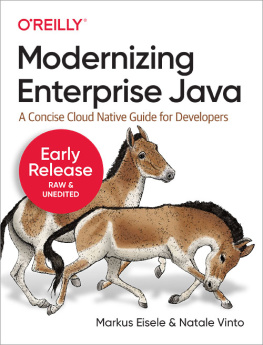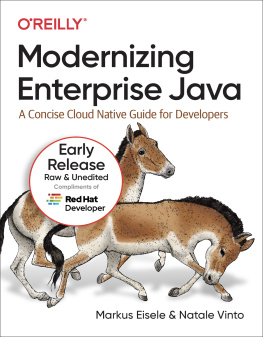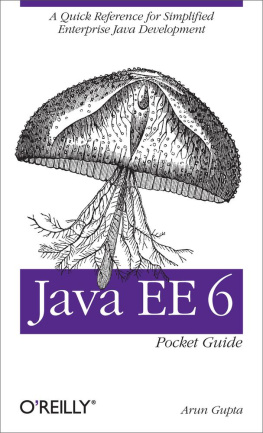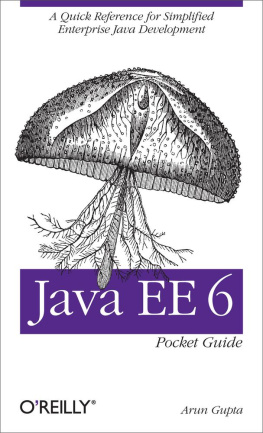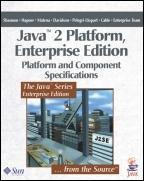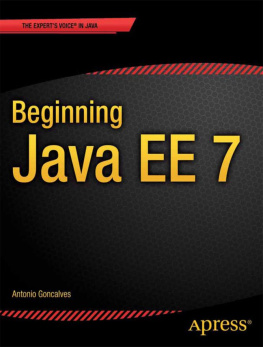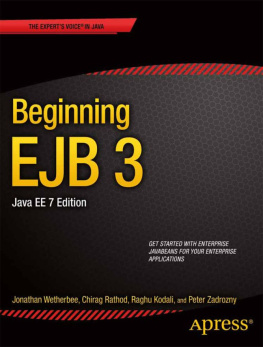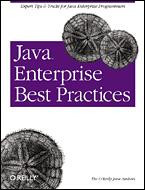Markus Eisele - Modernizing Enterprise Java
Here you can read online Markus Eisele - Modernizing Enterprise Java full text of the book (entire story) in english for free. Download pdf and epub, get meaning, cover and reviews about this ebook. year: 2021, publisher: OReilly Media, Inc., genre: Computer. Description of the work, (preface) as well as reviews are available. Best literature library LitArk.com created for fans of good reading and offers a wide selection of genres:
Romance novel
Science fiction
Adventure
Detective
Science
History
Home and family
Prose
Art
Politics
Computer
Non-fiction
Religion
Business
Children
Humor
Choose a favorite category and find really read worthwhile books. Enjoy immersion in the world of imagination, feel the emotions of the characters or learn something new for yourself, make an fascinating discovery.
- Book:Modernizing Enterprise Java
- Author:
- Publisher:OReilly Media, Inc.
- Genre:
- Year:2021
- Rating:4 / 5
- Favourites:Add to favourites
- Your mark:
- 80
- 1
- 2
- 3
- 4
- 5
Modernizing Enterprise Java: summary, description and annotation
We offer to read an annotation, description, summary or preface (depends on what the author of the book "Modernizing Enterprise Java" wrote himself). If you haven't found the necessary information about the book — write in the comments, we will try to find it.
Modernizing Enterprise Java — read online for free the complete book (whole text) full work
Below is the text of the book, divided by pages. System saving the place of the last page read, allows you to conveniently read the book "Modernizing Enterprise Java" online for free, without having to search again every time where you left off. Put a bookmark, and you can go to the page where you finished reading at any time.
Font size:
Interval:
Bookmark:

by Markus Eisele and Natale Vinto
Copyright 2021 Markus Eisele and Natale Vinto. All rights reserved.
Printed in the United States of America.
Published by OReilly Media, Inc. , 1005 Gravenstein Highway North, Sebastopol, CA 95472.
OReilly books may be purchased for educational, business, or sales promotional use. Online editions are also available for most titles (http://oreilly.com). For more information, contact our corporate/institutional sales department: 800-998-9938 or corporate@oreilly.com .
- Acquisitions Editor: Suzanne McQuade
- Development Editor: Nicole Tache
- Production Editor: Caitlin Ghegan
- Copyeditor: TK
- Proofreader: TK
- Indexer: TK
- Interior Designer: David Futato
- Cover Designer: Karen Montgomery
- Illustrator: Kate Dullea
- November 2021: First Edition
- 2021-07-20: First release
See http://oreilly.com/catalog/errata.csp?isbn=9781098102142 for release details.
The OReilly logo is a registered trademark of OReilly Media, Inc. Modernizing Enterprise Java, the cover image, and related trade dress are trademarks of OReilly Media, Inc.
The views expressed in this work are those of the authors, and do not represent the publishers views. While the publisher and the authors have used good faith efforts to ensure that the information and instructions contained in this work are accurate, the publisher and the authors disclaim all responsibility for errors or omissions, including without limitation responsibility for damages resulting from the use of or reliance on this work. Use of the information and instructions contained in this work is at your own risk. If any code samples or other technology this work contains or describes is subject to open source licenses or the intellectual property rights of others, it is your responsibility to ensure that your use thereof complies with such licenses and/or rights.
978-1-098-10214-2
[TK]
With Early Release ebooks, you get books in their earliest formthe authors raw and unedited content as they writeso you can take advantage of these technologies long before the official release of these titles.
This will be the 1st chapter of the final book. Please note that the GitHub repo will be made active later on.
If you have comments about how we might improve the content and/or examples in this book, or if you notice missing material within this chapter, please reach out to the authors at (Natale Vinto).
Enterprise development has always been one of the most exciting fields of software engineering, and the last decade has been a particularly fascinating period. The 2010s saw highly distributed microservices gradually replace classic three-tier architectures, with the almost limitless resources of cloud-based infrastructure pushing heavyweight application servers towards obsolescence.While developers are challenged with putting the pieces of the distributed world back together, plenty of voices question the necessity for this complex microservices world.The reality is that most applications are still well-crafted monolithic applications that follow a traditional software development process.
However, the way we deploy and operate software has changed equally fast. We have seen DevOps growing into GitOps, Expanding developers responsibilities beyond the application code including the required infrastructure. Building on Markus book Modern Java EE Design Pattern, this book puts more perspective on modernization than just modularization. We want to help you understand the various pieces that lead to a modern, Kubernetes-native development platform and how to build and maintain applications on top of it.
This book aims to step back and evaluate the success factors and drivers for application modernization and cloud-native architectures. We focus on modernizing Java-based Enterprise Applications, including a selection process for which applications are suitable for modernization and an overview of tools and methodologies that help you manage your modernization efforts. Instead of talking about patterns, this book provides a set of examples to help you apply everything you learned.That said, this book isnt discussing monolithic vs. distributed applications extensively. Rather, our goal is to help you understand how to seamlessly move your applications to the cloud. You can use this book as a reference and read chapters in any order. We have organized the material, though, starting with higher-level concepts to implementation in iterations. First, its important to start by looking at the different definitions of clouds and how we build applications for them.
The differences between public clouds, private clouds, hybrid clouds, and multi clouds were once easily defined by location and ownership. Today, these two are no longer the only relevant drivers for the classification of clouds. Lets start with a more comprehensive definition of the different target environments and why they are used.
A public cloud environment is usually created from resources not owned by the end-user that can be redistributed to other tenants. Private cloud environments solely dedicate their resources to the end-user, usually within the users firewall, data-center, or sometimes on-premises. Multiple cloud environments with some degree of workload portability, orchestration, and management are called hybrid clouds. Decoupled, independent, and not connected clouds are commonly referred to as multi clouds. Hybrid and multi cloud approaches are mutually exclusive; you cant have both simultaneously because the clouds will either be interconnected (hybrid cloud) or not (multi cloud).
Deploying applications to a cloud, regardless of the type of cloud, is becoming more common across enterprises as they seek to improve security and performance through an expanded portfolio of environments. But security and performance are only two of many reasons to move workloads into hybrid or multi cloud environments. The primary motivation for many is the pay-for-what-you-use model. Instead of investing in costly on-premises hardware that is hard and expensive to scale out, clouds offer resources when you need them. You dont have to invest in facilities, utilities, or building out your own data center. You do not even need dedicated IT teams to handle your cloud data center operations, as you can enjoy the expertise of your cloud providers staff.
For developers, the cloud is about self-service and flexibility. You dont have to wait for environments to be promoted and you cant choose infrastructure components (e.g., databases, message brokers, etc.) as a need arises to free you from unnecessary wait times and ultimately speed up development cycles. Beyond these primary advantages, you can also find custom features for developers in some cloud environments. OpenShift, for example, has an integrated development console that provides developers with direct edit access to all details of their application topology. Cloud-based IDEs (e.g., Eclipse Che) provide browser-based access to development workspaces and eliminate local environment configuration for teams.
Additionally, cloud infrastructures encourage you to automate your deployment processes. Deployment automation enables you to deploy your software to testing and production environments with the push of a button a mandatory requirement for agile development and DevOps teams. Youve seen a need for 100% automation already when youve read about microservices architectures. But automation goes well beyond the application parts. It extends to the infrastructure and downstream systems. Ansible, Helm, and Kubernetes Operators help you. We talk more about automation in chapter four, and youll use an Operator in chapter seven.
Font size:
Interval:
Bookmark:
Similar books «Modernizing Enterprise Java»
Look at similar books to Modernizing Enterprise Java. We have selected literature similar in name and meaning in the hope of providing readers with more options to find new, interesting, not yet read works.
Discussion, reviews of the book Modernizing Enterprise Java and just readers' own opinions. Leave your comments, write what you think about the work, its meaning or the main characters. Specify what exactly you liked and what you didn't like, and why you think so.

